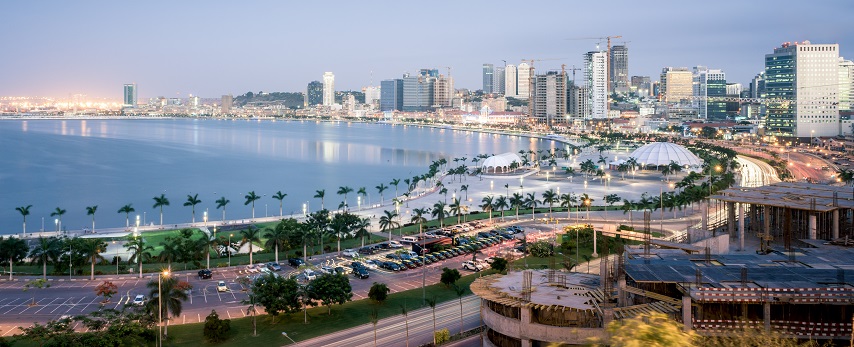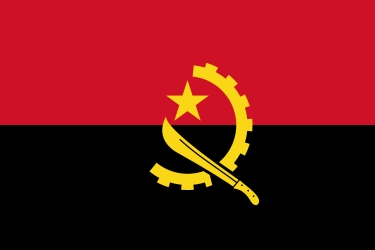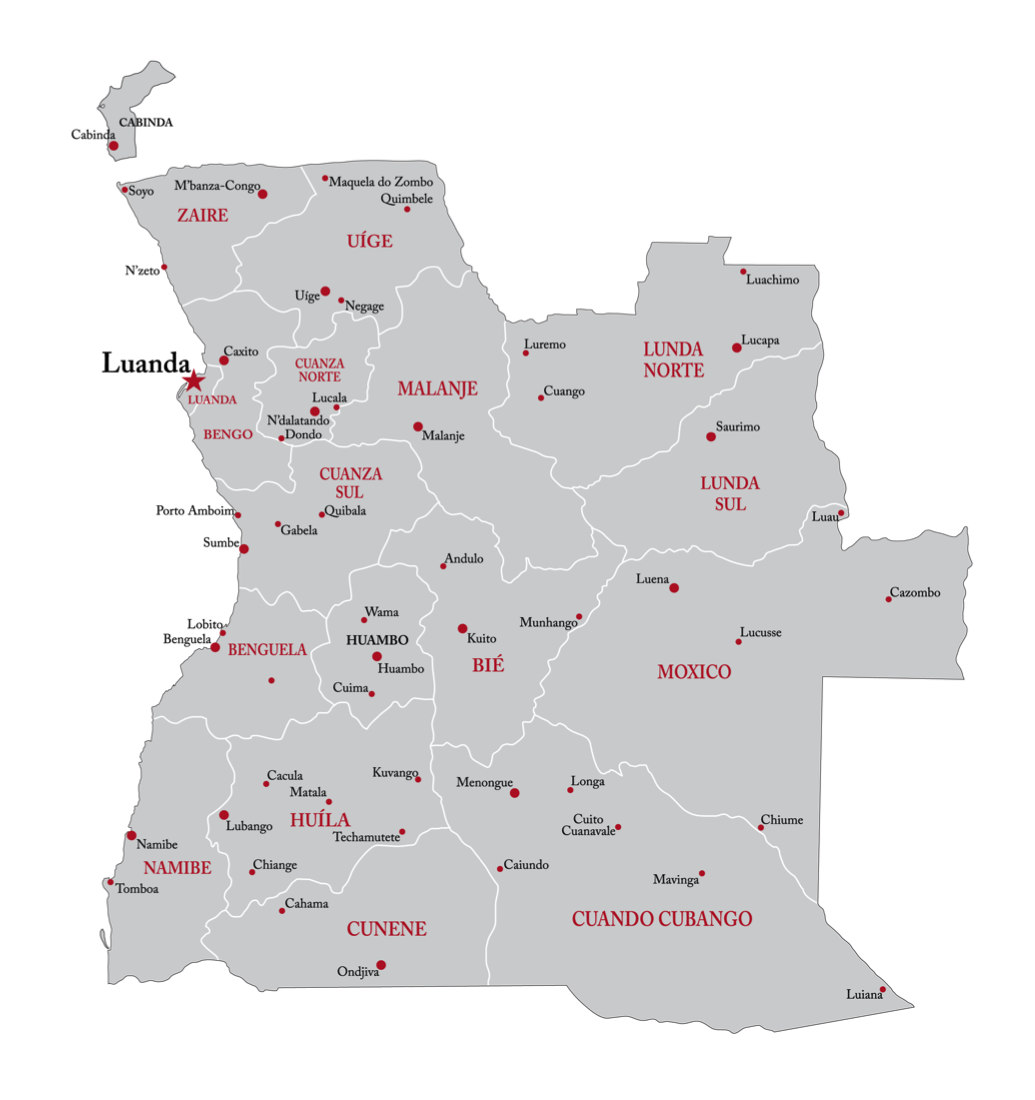


| Official name | Angola, Republic of Angola |
| Area | Total: 1,246,700 sq km Water: negligible |
| Population | 24,383 million |
| Official language | Portuguese |
| Capital | Luanda |
| Administrative division | Angola is divided in 18 provinces: Bengo, Benguela, Bié, Cabinda, Cuando Cubango, Cuanza Norte, Cuanza Sul, Cunene Huambo, Huila, Luanda, Luanda Norte, Luanda Sul, Malange, Moxico, Namibe, Uíge and Zaire.This provinces are further divided in 163 municipalities, which are divided in 475 communes (townships). |
| Location | Angola is located in on the Western Atlantic Coast of Southern Africa, between Namibia and the Republic of the Congo. It’s also bordered, to the East, by Zambia, and by the Atlantic Ocean by the West. Has 1,600 Km of coast and currently has an Exclusive Economic Zone of 370 Km (200 nautical miles). |
| Climate | Angola’s climate varies considerably from the coast to the central plateau. There are two seasons: a dry and cool season from June to late September, and a rainy, hot season from October to April or May. The Average temperature is 20ºC (68ºF) and the temperatures are warmer along the coast and cooler on the central plateau. |
| Time zone | WAT (West Africa Time); UTC/GMT + 1 hour; No DST (Daylight Saving Time). |
| Neighbours | Democratic Republic of the Congo, Zambia and Namibia. |
| Mountains | The highest peak of Angola is Mount Coco, with 2,620 m (8,600 ft). Other high points are, for instance, Loviti (Benguela Province), reaching 2,370 m (7,780 ft) or the volcanic mountain south of the Cuanza, Caculo-Cabaza, reaching 1000 m (3,300 ft). The approach the central plateau is marked by the west-central highlands, a series of irregular escarpments and slopes, like Tala Mugongo (4,400 ft or 1,300 m) and Chella and Vissecua (5,250 ft or 1,600 m). The Cuanza river divides the mountain zone in two parts. |
| Main/ major rivers | Cuanza River (966 km/600 miles) Cuango (855 km/531 miles) Cuando (735 km/ 451 miles) |
| Largest lakes | Lake Dilolo |
| Mineral resources/wealth | The main mineral resources of Angola are diamonds and iron ore. In addition to these two main resources, Angola has manganese, copper, gold, phosphates, granite, marble, uranium, quartz, lead, zinc, wolfram, tin, fluorite, sulfur, feldspar, kaolin, mica, asphalt, gypsum and talk. |
| Major cities | *Luanda *Huambo *Lobito *Benguela *Lucapa |
| Demography | Population – 24.383 million (Census 2014) Urban population – 59,14% (data of 2011) Rural population – 41,86% (data of 2011) |
| Main religion | Roman Catholic (half of the population) |
| GDP | PPP: Total: 139.059 billion USD (113 billion EUR) Per capita: 6,484 USD (5,269 EUR)
Nominal: Total: 131.407 billion USD (107 billion EUR) Per capital: 6.127 USD (5.000 EUR)
|
| Currency | Kwanza (AOA) EUR= 124,931 AOA USD= 101,490 AOA |
| Emergency telephone numbers | Medical Emergency (Ambulance): 112 Police: 113 Fire Department: 115 |
| Unemployment rate | 26% (January 2014) |
| Constitution | Constitution of the Republic of Angola |
| The political system | The Republic of Angola is a Presidential Republic and has a multi-party system. The President of Angola is the Head of State and holds the Executive Power. The Angolan parliament, the National Assembly, exercises de Legislative Power. |
| President | João Lourenço |
| Vice President | Bornito Sousa |
| The Legislature | The National Assembly is the Parliament of the Republic of Angola. The National Assembly is a unicameral body representing all the Angolans and expresses the sovereign will of the Angolan people and exercises the State´s legislative power and is composed by Members elected on the terms of the Constitution and the Law.The Members of the Parliament are elected by universal, equal, direct, secret and periodic suffrage by the national citizens over eighteen years old and residents on national territory, being equally considered all the Angolan Citizens living abroad due to its duties, studies, and illnesses or similar. The deputies of the parliament are elected through the system of proportional representation, for a five year term, according to the terms of the law. |
| The Executive | The President of the Republic is the Head of State, the holder of the Executive Power and the Commander-in-chief of the Angolan Armed Forces. The President exercises the executive power, assisted by a Vice-President, Ministers of State and Ministers, and promotes and ensures the national unity, the independency and territorial integrity of the country. The President of the Republic represents the nation at the domestic and international levels, respects and defends the Constitution and ensures compliance with the laws and international agreements and treaties. The President also promotes and secures the regular operation of the Organs of the State. |
| The judicial branch | The courts are the sovereign body with powers to administer justice on behalf of the people. In exercising their jurisdictional duties, the courts are independent and impartial and subject only to the Constitution and law. The Higher Courts of the Republic of Angola are the Constitutional Court, the Supreme Court, the Audit Department of Exchequer and the Supreme Military Court. The courts guarantee and ensure compliance with the Constitution, Laws and all the legal provisions in force, protection of the rights and legitimate interest of citizens and institutions, and decide on the legality of administrative acts. The court verdicts are compulsory for all the citizens and legal persons and shall prevail over those from any other authorities. The judges are independent on the exercise of their duties and owe obedience only to the Constitution and law. |
| Foreign Policy | Membership in International Organizations: *UN (United Nations) *WCO (World Customs Organization) *WTO (World Trade Organization) *CPLP (Community of Portuguese Language Countries) *WHO (World Health Organization) *OPEC (Organization of Petroleum Exporting Countries) *IMF (International Monetary Fund) *ACP (African, Caribbean and Pacific Group of States) |
Road transport Travelling on highways outside of towns and cities in Angola (and in some cases within) is often not best advised for those without four-by-four vehicles. While a reasonable road infrastructure has existed within Angola, time and the war have taken their toll on the road surfaces, leaving many severely potholed, littered with broken asphalt. In many areas drivers have established alternate tracks to avoid the worst parts of the surface, although careful attention must be paid to the presence or absence of landmine warning markers by the side of the road. Detailed Road Map of Angola *Luanda to Huambo: 516 km *Luanda to Lobito: 513 km *Huambo to Lobito: 315 km 2001 Data: *Total extension of the roads: 51,429 km *Paved: 4,349 km *Unpaved: 46,080 km Rail transport There are three separate unconnected lines: *The Luanda Railway, the northern railway, is a 424km single track, and it’s a cape gauge railway line from Luanda to Malanje, for normal passenger and freight service. *The Benguela Railway, the central railway, connects the Atlantic port of Lobito to the border town of Luau and to the railway networks of the Democratic Republic of the Congo, of Zambia and beyond. It’s 1,344 km cape gauge railway. *The Moçãmedes Railway, the southern railway, is a 907 km railway line between Namibe and Menongue. Renovation completed in 2012. Buses Due to the poor road infrastructure the bus services are limited. Some buses serve routes throughout the country, but they are usually very crowded. However, in the capital Luanda the private bus company TURA (Transporte Urbano Rodoviario de Angola) operates. Furthermore, most hotels will provide airport shuttles. Air transport Angola has a total of 243 airports, of which 32 are paved. The main ones can be found in the following map:
Angola is a country with long coastline, and it has borders with Namibia, Botswana, Democratic Republic of Congo and Zambia (WorldBank, 2020). Angola has the third largest GDP in the sub-Saharan Africa, after Nigeria and South Africa and is the second largest oil producer in Africa (Anon., 2021). After the civil war, Angola faced the highest economic growth rates in the world due to its oil wealth (Anon., 2021).
However, and even with some efforts in the macroeconomic stability and in structural reforms, there was a contraction in the GDP of 1,2% in 2018, due to the fall of the petroleum prices, that contributes for 1/3 of the GDP and to 90% of exportations, and due to the fall of production levels (WorldBank, 2020).
The government has made some efforts in reforms that produced positive outcomes with Angola exploring again the euro-obligations markets of $3,0 thousand million and with the IMF allowing the second revision of the program EFF in 2019 (Worldbank, 2020). These reforms, were the new law of prevention and combat of money laundering, with privatizations, with one stop shop for the investors to turn the empresario world in a better one, with the establishment of social protection in relation with the vulnerable ones (WorldBank, 2020), with the investments in infrastructure, human capital, credit markets, that would permit an economic diversification, a improve of the account balance and the generation of international reserves of oil and diamonds, that would permit and economic recovery from 2020 onward (ADBG, 2020). However, in 2020 Angola had a recession due to the fall of the petroleum prices, that is being affected by the clash between demand and offer, and due to the impact of the Covid-19 pandemic (ADBG, 2020). The GDP revised own to 5.3% in June 2020 and in July 2020 the “Banco Fomento Angola”, also forecast a recession of 5% in the Angola economy, that is the biggest contraction since the civil war (Goulão, 2020). The Banco Fomento Angola, also projected that the economic progress will be dependent on the evolution of the pandemic and dependent on the negotiations with creditors and multilateral partners, like IMF and World Bank (Goulão, 2020).
In 2021 it is expected a recovery of the economy, due to the external and domestic demand, but with high rated of unemployment, social unrest, public debt, notable fiscal shortfall and currency weakness. It is expected by FocusEconomis an expansion of 1.3% of the GDP in 2021 and with 2.4% in 2022 (FocusEconomics, 2020).
Doing Business in Angola
Although Angola is passing by a crisis, like most of the countries in the world, due to the Covid-19 pandemic, there are still a lot of reasons to invest in Angola.
First, Angola is a rich country, with ample reserves of natural resources, like diamonds, natural gas, and other minerals (Simbrão, 2017), which means that it is a country where foreign investors can invest in natural resources, because the country has a lot of them.
Second, besides the above-mentioned natural resources, there is one in particular that is very important, it is the crude oil, because Angola is the second largest producer of it in Africa, which means that it could be a good opportunity for the foreign investors to invest (Simbrão, 2017).
Third, it is a country with an extensive arable land and with a tropical climate, that promotes a good place for agriculture, fishing, hunting, livestock and tourism, which means that the foreign investors have a lot of land that can invest, that can give different things to the investors (Simbrão, 2017).
Forth, the new Private Investment Law, passed by the government, to promote and improve the business environment of Angola, to make the market attractive for private and foreign investment. It consists in principles and rules for the benefits and facilities provided by the state, like tax, foreign exchange incentives, customs, to establish partnerships for developments projects of construction, expansion and rehabilitation of infrastructures of different sectors (Simbrão, 2017). This means that the foreign investors will have benefits if they decide to invest in Angola.
Fifth, the geographical location and strategic position, that is a good access platform to the regional market of Southern Africa and land-locked countries, that means that foreign investors could not only get to the consumers market of Angola but also of other regions in Africa (Simbrão, 2017).
Sixth, Angola doesn’t have occurrences of complicated natural disasters, which means that the foreign investors would not have many problems with physical environment, resources and facilities (Simbrão, 2017).
Seventh, Angola is a country that offers a good and stable business environment, with rising middle-class, growing market, young and active population, with public investments in construction and with economic and social infrastructures (Simbrão, 2017).
Besides these seventh facts to invest in Angola, it is also important to take into account which sectors would be promisors for the investment of foreign investors. The most promising sectors are the agriculture, livestock production and forestry; manufacturing and processing industries; fisheries and aquaculture; construction and housing support; healthcare (preventice medicine, pharmaceutical industry); Education (regular education and Technical-vocational training); Transport and Telecommunications; Hospitality and Tourism; and IT and Management Technology (Simbrão, 2017), because these sectors have “potential and incentives put in place” (Anon., 2021).
After years of civil war that destroyed the country’s communication and hospitality infrastructures, Angola has been living an economic growth period with the national government highly investing in the country’s reconstruction. Luanda is nowadays a business hub, attracting several international companies in various areas from finance, to engineering and tourism. Although business being the main purpose of tourism in the country, leisure has also been rising as new touristic routes are created and market players become increasingly competitive. To promote sustainable growth, the Angola government has designed a plan to boost the country’s touristic demand.
| Accommodation | Hotels: 81 |
| Tourist attractions | Valley of the Moon, Kalendua Waterfalls, Black Stones, Coatinha Beach, Tazua Falls, Luanda’s Island and Bay, Cameia National Park, Cangandala National Park, |
| The most visited cities | Luanda, Malanje, Namibe, Moxico |